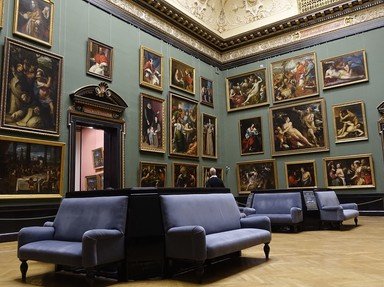Quiz Answer Key and Fun Facts
1. Like many great museums, the Joslyn is something of a work of art in itself. In what style, dominant when the gallery opened in 1931, was it designed?
2. The Joslyn is perhaps best known for its extensive holdings of Karl Bodmer's paintings. Though Swiss, Bodmer is known for his work documenting uniquely American phenomena. What is the Omaha-appropriate focus of much of Bodmer's best-known work?
3. Like many Midwestern museums, the Joslyn has a substantial collection of Impressionist art. One of their most valued pieces is a plaster impression of "Little Dancer, Aged Fourteen" by what artist, better known for his painting?
4. In an effort to broaden the influence of her collection, Peggy Guggenheim allowed Joslyn curators to pick one of her "surplus" works to beef up their modernist offerings. The Joslyn people chose "Galaxy", a 1947 effort by one of the most innovative artists of all time; this piece remains one of their proudest offerings. Who was the creative giant, known for his "splatter" paintings, who created "Galaxy"?
5. One of the Joslyn's signature holdings is "Le Printemps" by academic painter William-Adolphe Bouguereau. What is unusual about the history of this painting?
6. Joslyn's 1582 piece by Spanish Renaissance painter El Greco, "Saint Francis in Prayer", shows the holy subject meditating on death and salvation. Salvation is symbolized by Christ on the cross; what image is used here to represent mortality?
7. Perhaps the most highly-regarded Renaissance painting at the Joslyn is 1537's "Giorgio Cornaro with a Falcon" by Tiziano Vecelli, one of Venice's greatest painters of the era. By what name is Tiziano Vecelli better known?
8. As mentioned above, the Joslyn has been able to accumulate a collection of Impressionist art that is reasonably representative of the movement. Which of these is not an Impressionist in the Joslyn's galleries?
9. As you might expect, the Joslyn has a wide-ranging collection of American works, many of them representative of the American West. Which of these is NOT an American painter whose work is on display at the Joslyn?
10. Finally, the Joslyn has a small--but respectable--collection of world art. Which of the following would you NOT see on display there?
Source: Author
stuthehistoryguy
This quiz was reviewed by FunTrivia editor
CellarDoor before going online.
Any errors found in FunTrivia content are routinely corrected through our feedback system.

